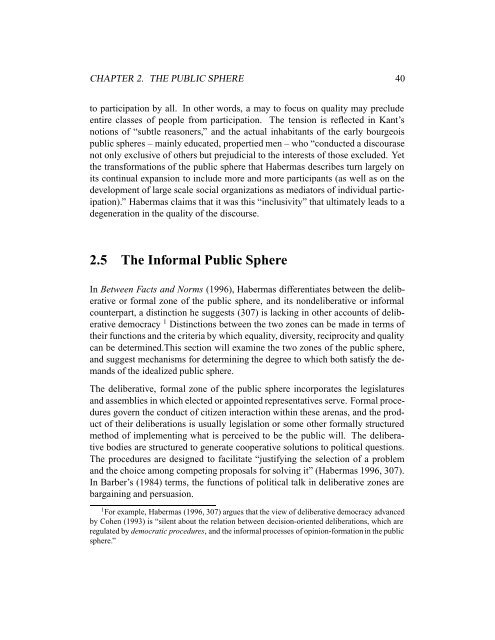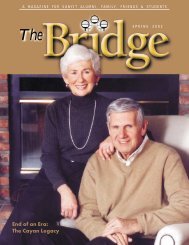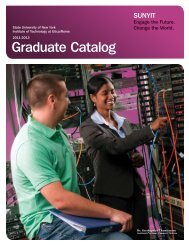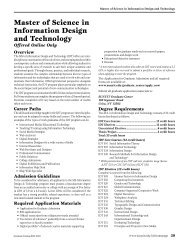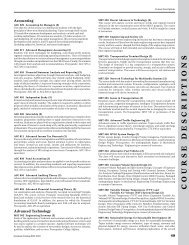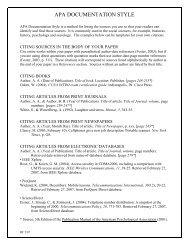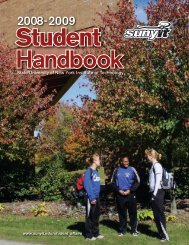Expanding the Public Sphere through Computer ... - ResearchGate
Expanding the Public Sphere through Computer ... - ResearchGate
Expanding the Public Sphere through Computer ... - ResearchGate
You also want an ePaper? Increase the reach of your titles
YUMPU automatically turns print PDFs into web optimized ePapers that Google loves.
CHAPTER 2. THE PUBLIC SPHERE 40<br />
to participation by all. In o<strong>the</strong>r words, a may to focus on quality may preclude<br />
entire classes of people from participation. The tension is reflected in Kant’s<br />
notions of “subtle reasoners,” and <strong>the</strong> actual inhabitants of <strong>the</strong> early bourgeois<br />
public spheres – mainly educated, propertied men – who “conducted a discourase<br />
not only exclusive of o<strong>the</strong>rs but prejudicial to <strong>the</strong> interests of those excluded. Yet<br />
<strong>the</strong> transformations of <strong>the</strong> public sphere that Habermas describes turn largely on<br />
its continual expansion to include more and more participants (as well as on <strong>the</strong><br />
development of large scale social organizations as mediators of individual participation).”<br />
Habermas claims that it was this “inclusivity” that ultimately leads to a<br />
degeneration in <strong>the</strong> quality of <strong>the</strong> discourse.<br />
2.5 The Informal <strong>Public</strong> <strong>Sphere</strong><br />
In Between Facts and Norms (1996), Habermas differentiates between <strong>the</strong> deliberative<br />
or formal zone of <strong>the</strong> public sphere, and its nondeliberative or informal<br />
counterpart, a distinction he suggests (307) is lacking in o<strong>the</strong>r accounts of deliberative<br />
democracy 1 Distinctions between <strong>the</strong> two zones can be made in terms of<br />
<strong>the</strong>ir functions and <strong>the</strong> criteria by which equality, diversity, reciprocity and quality<br />
can be determined.This section will examine <strong>the</strong> two zones of <strong>the</strong> public sphere,<br />
and suggest mechanisms for determining <strong>the</strong> degree to which both satisfy <strong>the</strong> demands<br />
of <strong>the</strong> idealized public sphere.<br />
The deliberative, formal zone of <strong>the</strong> public sphere incorporates <strong>the</strong> legislatures<br />
and assemblies in which elected or appointed representatives serve. Formal procedures<br />
govern <strong>the</strong> conduct of citizen interaction within <strong>the</strong>se arenas, and <strong>the</strong> product<br />
of <strong>the</strong>ir deliberations is usually legislation or some o<strong>the</strong>r formally structured<br />
method of implementing what is perceived to be <strong>the</strong> public will. The deliberative<br />
bodies are structured to generate cooperative solutions to political questions.<br />
The procedures are designed to facilitate “justifying <strong>the</strong> selection of a problem<br />
and <strong>the</strong> choice among competing proposals for solving it” (Habermas 1996, 307).<br />
In Barber’s (1984) terms, <strong>the</strong> functions of political talk in deliberative zones are<br />
bargaining and persuasion.<br />
1 For example, Habermas (1996, 307) argues that <strong>the</strong> view of deliberative democracy advanced<br />
by Cohen (1993) is “silent about <strong>the</strong> relation between decision-oriented deliberations, which are<br />
regulated by democratic procedures, and <strong>the</strong> informal processes of opinion-formation in <strong>the</strong> public<br />
sphere.”


